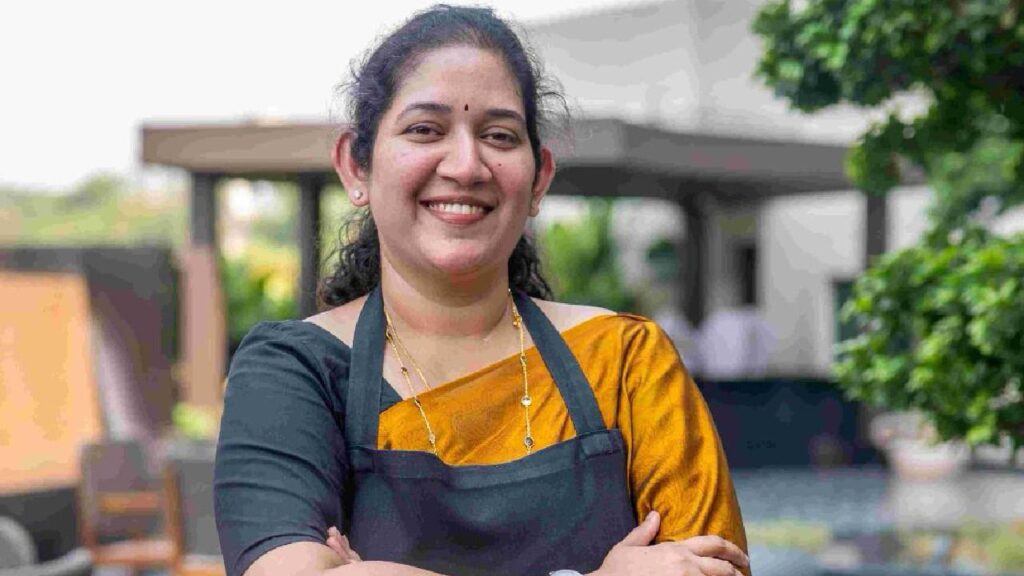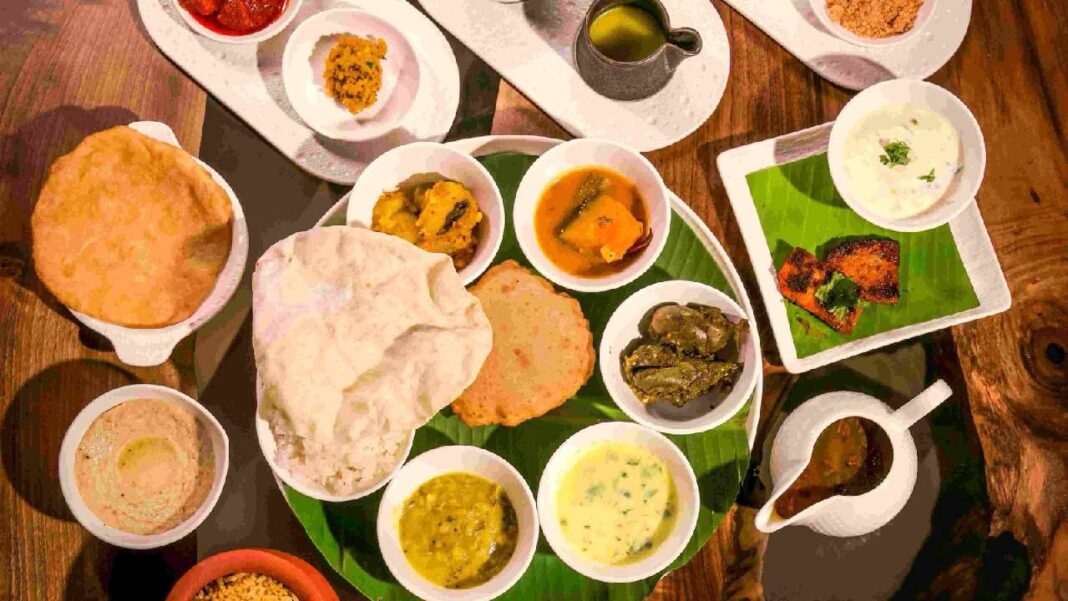Tejal Sinha
tejal.sinha30@gmail.com
There’s a moment—just before the first morsel touches your lips—when you realise this is not merely a meal. It’s an invitation to a land of red soils, hand-pounded spices, and the rhythmic sounds of stone grinders. At Raen – The Chef’s Studio in The Leela Hyderabad, Chef Meera’s Echoes of Andhra (running from May 9 to 18) curates not just food, but feeling—a visceral journey through Andhra Pradesh’s bold, blazing, and beautiful culinary map.
From the very first glance, the thali arrives like a well-composed raga—each bowl, a note; each texture, a memory. This is not a tasting menu; it is an edible chronicle.
Kanda Vepudu, the humble elephant yam, emerges transformed—pan-seared until its edges develop a crisp, caramelised char, its flesh remaining firm and meaty. Coated in dry roasted spices that deliver a gentle burn rather than a fiery hit, it balances heat and restraint, embodying the Andhra art of controlled fire.
Beside it rests a serene counterpoint: Perugu Vada. The urad dal fritter, pillowy and tender, is bathed in tempered curd laced with mustard seeds, curry leaves, and slivers of green chilli. With every mouthful, it soothes the palate—a cooling sigh between the spice-kissed crescendos of the meal.
Then arrive the pachadis, the crown jewels of Andhra homes. The Dosa Avakai, a fiery mango pickle, greets you with its fermented tang and unapologetic pungency. It’s bold, wild, and unrelenting, like a grandmother who doesn’t soften her words but leaves a mark you never forget.
Its cousin, the Vellulli Dosakaya Pachadi, made with yellow cucumber and raw garlic, is no less commanding. Here, the sharpness of garlic and the watery crunch of cucumber come together in a flirtatious sting—intense, bracing, and sharply acidic in a way that awakens you from within.
But the softest whisper is also the most poetic: Kobbari Mamidikaya Roti Pachadi, a thick, hand-pounded chutney of grated coconut and raw mango. It tastes like shaded courtyards and monsoon afternoons, its tartness mellowed by the creamy nuttiness of coconut. Every spoonful speaks of quiet rituals—of women gathered in kitchens, grinding memory into flavor on stone.
From soft to sharp, the thali swings like a pendulum of sensation. Enter the Podis—dry, coarse, and deeply aromatic spice powders. The Kandi Podi, made from roasted toor dal, is nutty, smoky, and almost sand-like, begging to be mixed into rice with a dollop of hot ghee. The Palli Podi, its peanut-based sibling, adds an earthy richness with the faintest hint of jaggery, giving it a whisper of sweetness amidst its fiery backbone.
But it is the Oora Mirapakayalu, the sun-dried green chillies fried until blistered and leathery, that gives the thali its dangerous thrill. Just a nibble and your lips tingle, your tongue dances—this is not garnish, this is rebellion in edible form.
And then, there’s Appadalu, the Andhra papad. Not just a crunchy side, but a punctuation mark—light as air yet assertive. Roasted to perfection, it shatters between your fingers with a sharp crackle and pairs beautifully with rice and ghee, or simply as a crumble atop coconut rice. It’s the dish that speaks when others whisper. Vadiyalu, its sun-dried cousin, adds its own crisp counterpoint—each bite salty, spicy, and addictive.
As the meal builds, the soul of Andhra cuisine reveals itself in its dals. Chinthachiguru Pappu, made with tender tamarind leaves, is as rare as it is soulful. Slightly tangy, deeply vegetal, and lush with ghee, it clings to rice with the intimacy of comfort and memory. It’s a seasonal treasure, the kind you chase every year and miss when it’s gone.
Kandi Pappu, on the other hand, is home in a bowl. Tempered with ghee, garlic, green chillies, and mustard seeds, this toor dal dish is elegant in its simplicity—mellow, nurturing, and reminiscent of weekday lunches and steel tiffin boxes.
The vegetables too, are not afterthoughts—they are protagonists in their own right. Vankaya Kothimeera Karam brings together slender green brinjals and a paste of freshly ground coriander leaves. Fragrant, vivid, and slightly tangy, it’s a green herb symphony anchored by the subtle bitterness of the aubergine. The Bangala Dumpa Ullikaram—potatoes smothered in onion and chilli paste—builds slowly. Its heat doesn’t punch; it simmers. Each bite warms your cheeks and makes you reach instinctively for a sip of buttermilk, before you dive back in for more.
And then comes the show-stealer: Dhapalam. A stew of pumpkin, sweet potato, and bottle gourd, it is mellow and comforting, yet layered with spice. The vegetables melt on the tongue, suspended in a thin, slightly sweet broth that binds the plate like memory binds nostalgia.
No Andhra thali is complete without its grains. The puri—an ideal companion for scooping up chutneys and kooras. The Sona Masoori rice, delicate and fluffy, acts as the blank canvas upon which all these flavours dance. But it’s the Kobbari Palam Annam, rice infused with coconut milk and mild spices, that turns heads. Its gentle sweetness, paired with toasted cashews and a whiff of cardamom, brings a sense of festivity and indulgence—like a Sunday lunch stretched into the afternoon.
Just as you think it’s winding down, the broths arrive: the Pulusus and Charus. Menthi Majjiga, a chilled buttermilk stew tempered with mustard and fenugreek, soothes the fire with its lactic tang and herbal undertone. Inguva Charu, a thin tamarind broth heady with asafoetida, is the kind of dish you sip with both hands—a spicy, sour elixir that wakes every nerve in your body.
And then, the final act—the sweets. Sojjapalu, fried pastries stuffed with spiced semolina halwa, arrive golden and glistening. They flake at first bite, giving way to the ghee-soaked warmth within. It’s indulgence, wrapped in nostalgia. Alongside is Junnu, a rare custard made from colostrum milk. Its texture is dense yet silken, its flavour a perfect balance of sweetness, spice, and an almost maternal warmth. It’s not just dessert—it’s a lullaby.

This is what Echoes of Andhra does so well. It doesn’t just feed you—it speaks to you, in flavours that are loud, loving, and alive. Under Chef Meera’s careful orchestration, every element has a voice. And together, they compose a thali that feels less like a plate and more like a poem. Come hungry. Leave transformed!
Chef Meera, an architect by profession, has spent years nurturing her passion for cooking, particularly focusing on reviving forgotten recipes and rediscovering seasonal ingredients. “While I’ve always been professionally an architect, cooking has always been my true passion,” she shares. Over the years, this passion has evolved into a mission to bring attention to lesser-known aspects of Andhra cuisine, which is often wrongly reduced to “spicy and hot” food. She explains, “What most people don’t realize is that Andhra cuisine is incredibly diverse. It’s rich in flavors, textures, and history. It goes far beyond just being spicy.”

With this pop-up, she aims to showcase this diversity by emphasizing ingredients that are often overlooked, despite their seasonal abundance. “I’ve developed a deep desire to bring together lost recipes and forgotten ingredients, especially seasonal produce that’s readily available but rarely used in everyday cooking. Seasonal produce, like tender tamarind leaves or raw mangoes, are often ignored, and it’s these ingredients that I want to highlight. This menu is special because it features some of these forgotten ingredients. For example, we have fresh, tender tamarind leaves, which are only in season for a couple of weeks, much like raw mangoes. These leaves are incredibly versatile and can be used in dals or even as a tangy base for meat dishes,” she says, explaining one of the highlights of the meal. The tamarind leaves make an appearance in a dal preparation, adding a unique depth of flavor.
Another signature ingredient in her menu is gongura, which is synonymous with Andhra cuisine. She explains, “Gongura is a green that is strongly associated with Andhra cuisine, especially in dishes like gongura pickle. It’s something many people know about, but it’s underutilized in its full potential. In today’s menu, I’ve prepared a traditional gongura mamsam, which is a rich meat dish that celebrates this unique green.”
Her cooking philosophy also includes a commitment to freshness and authenticity. “All the masalas in these dishes are freshly ground in-house, which makes a huge difference in the flavor profile,” she reveals. In addition to the thalis, diners are treated to an array of podis, or spice powders, which are a staple in Andhra meals.
She feels strongly about how the region’s food is often misrepresented in restaurants. “I believe that Andhra cuisine is often oversimplified or misrepresented in most restaurants. Menus are typically templated, offering the same few dishes with limited variety. Vegetables are often just deep-fried, and dals are indistinguishable from each other,” she says, expressing her frustration with the lack of depth in how Andhra food is presented outside of home kitchens.




